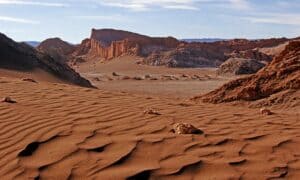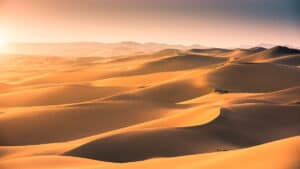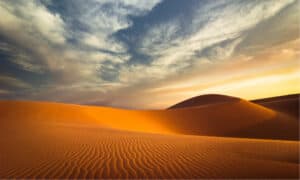The Sahara Desert, in Africa, is one of the most stunning landscapes in the world. Expanding from west to east Africa and from the Mediterranean Sea to the Sahel, the desert covers an area almost as vast as the United States.
Discover some mind-blowing facts about the Sahara Desert.
The Sahara Is the World’s Largest Hot Desert!
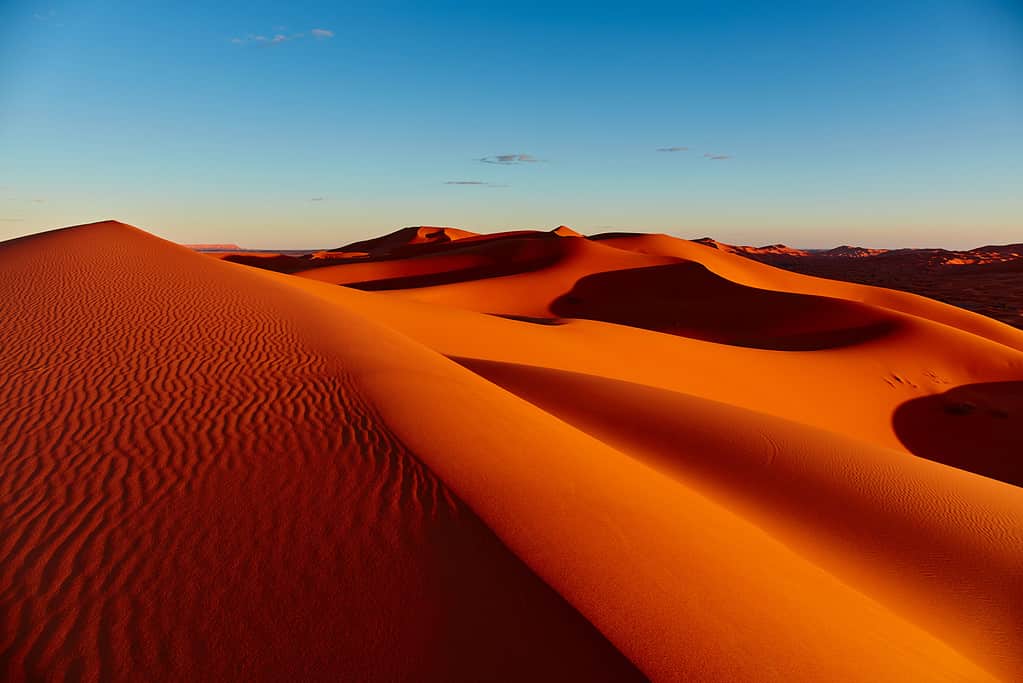
The Sahara Desert is larger than the area of the contiguous United States.
©ArturNyk/iStock via Getty Images
This immense desertic expanse covers approximately 3.6 million square miles (9.2 million square kilometers). With its vast size, the Sahara is undeniably the world’s largest hot desert. Its desertic landscapes extend from the coast of the Atlantic Ocean, west of the continent, to the Red Sea, east of Africa. It also spans from the Mediterranean Sea in the north to the Sahel region in the south.
The world’s largest hot desert covers ten countries and one disputed territory: Algeria, Chad, Egypt, Libya, Mali, Mauritania, Morocco, Niger, Sudan, Tunisia, and Western Sahara.
The Desert Is Famous for its Extreme Weather
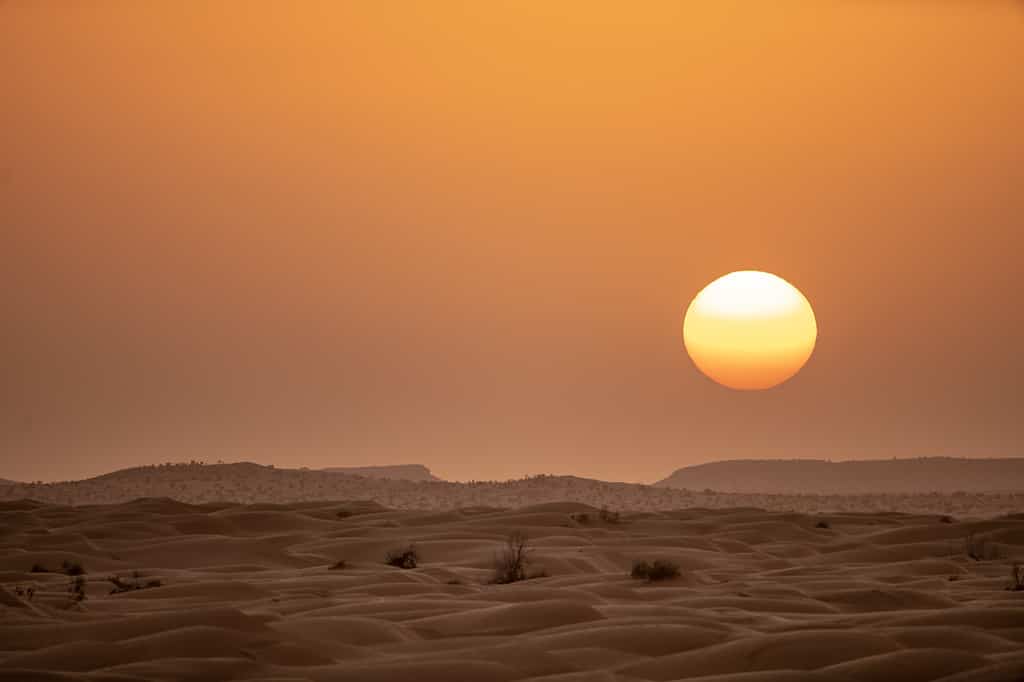
The Sahara Desert is one of the hottest places on Earth.
©skander zarrad/ via Getty Images
One of the most famous characteristics of the Sahara Desert is its extreme weather. Specifically during the summer, temperatures can easily reach above 100°F (40 °C) and sometimes exceed 122°F (50°C). The Sahara has a significant lack of cloud cover and often experiences warm winds, all contributing to the heat.
On the contrary, at night, temperatures in the Sahara drop significantly. Due to the lack of cloud cover and moisture in the air, temperatures can drop to freezing even during the hotter months. This leads to a significant temperature variation between day and night.
Various geographical and climatic factors influence the Sahara’s extreme temperatures. The extensive expanse of sand and rocks absorbs and retains heat during the day. Consequently, the Sahara’s albedo parameter — measures how much a surface reflects the sunlight — is low due to its dark-colored sand rocks. This means that most of the sunlight touching the ground is not reflected but absorbed.
Additionally, the Sahara is just south of the Tropic of Cancer. With this strategic location, the desert receives direct sunshine between 3,600 and over 4,000 hours of sunlight (82% to 92% of daylight hours). The sun’s rays strike the desert rocks and sand, concentrating the energy and heat.
What about rainfall? Well, the desert is already one of the hottest places on the planet but also one of the most arid. The average rainfall is less than 3 inches (76 mm). Some areas of the Sahara Desert have experienced years without any significant rain. The water’s scarcity and high evaporation rates result in a challenging environment for both fauna and flora.
The Sahara Is Home to Some of the World’s Tallest Dunes
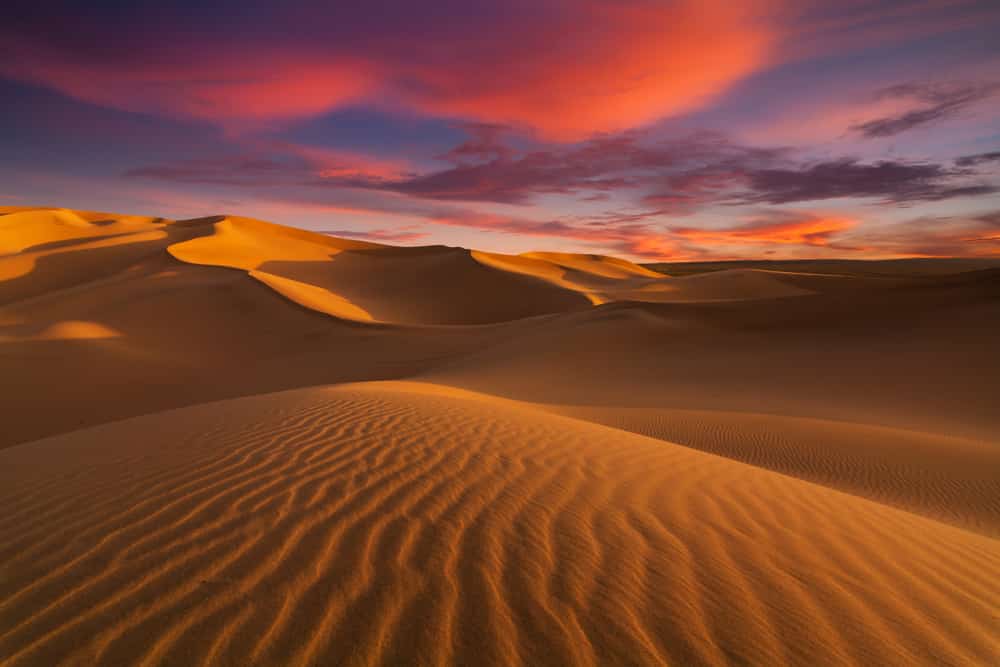
Dunes in the Sahara can reach up to 500 feet (150 meters).
©fogcatcher/Shutterstock.com
When people think of the Sahara, one image that comes to mind is often the endless golden or reddish-brown dunes extending as far as the eye can see. The Sahara is not home to the tallest sand dune on Earth, which is the Federico Kirbus, located in Argentina.
However, the Sahara has many sand dunes, some reaching over 500 feet (150 meters). The tallest dunes are mainly found in the Erg Chebbi region in Morocco. These reddish dunes are a stunning sight to see.
And Some Incredible Oases!

Oases are rare but are a vital part of the desertic ecosystem.
©Patrick Poendl/iStock via Getty Images
Another famous feature of the Sahara Desert is its multiple oases. These pockets of greenery are fed by underground aquifers filled with water from ancient rainfall. Thanks to the availability of water, oases are lush and green. Acacia trees, date palms, and palm trees thrive in these areas, making oases a unique ecosystem within the harsh desert environment.
These rare patches of water and lush greenery are a lifeblood for the wildlife. The vegetation and water sources attract birds, insects, and small mammals.
In addition to the wildlife, oases have historically attracted nomads and settlers. If some oases are only used as a stop during a traveling period, others are now the center of established communities, with crops and livestock. Date palms are a common crop in Sahara oases and are used in the local food. Oases also sustain grains, fruits, and vegetables.
In addition to being a lifeblood to humans, oases are often at the heart of cultural identity. Celebrations, ceremonies, and gatherings are often held near oases. Most of these communities keep a solid connection to a traditional way of life.
However, like every body of water, managing the waters is crucial. If overused, it can lead to depletion and the disappearance of an oasis. With increased desertification in the Sahara, the need to protect and preserve oases is becoming vital.
The Sahara Is Not Only Composed of Sand Dunes
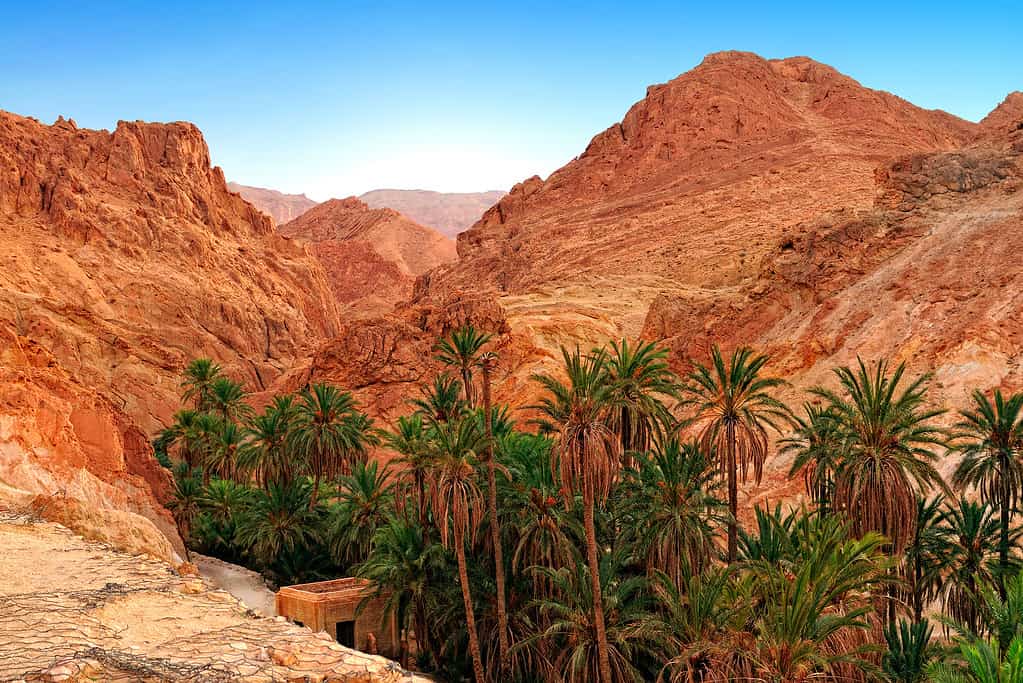
Roughly 70% of the Sahara is made of mountains, plateaus, and rocky areas.
©IgorSPb/iStock via Getty Images
If the desert is famous for its dunes and “sea of sand,” it is far from being only composed of sand. The Sahara is surprisingly diverse and home to a range of unique environments.
Outside of the iconic sand dunes, the Sahara also features rocky plateaus and mountains. In Algeria, the Hoggar Mountains rise from the desert floor and are stunning sights to see. They also have unique flora and fauna adapted to high-altitude desert conditions.
Another fascinating facet of the Sahara’s diverse ecosystem is its oases. Often featured in books and movies, they are the lifeblood of humans and wildlife crossing and living in the desert. The Siwa Oasis in Egypt and the Tuat Oasis in Algeria are famous and attract thousands of visitors.
In these environments live an array of specialized desert-adapted flora and fauna. Plants such as acacia trees, date palms, and various succulents have evolved to thrive in the harsh, water-scarce conditions of the Sahara Desert.
The Sahara Desert’s Landscape Is Constantly Changing
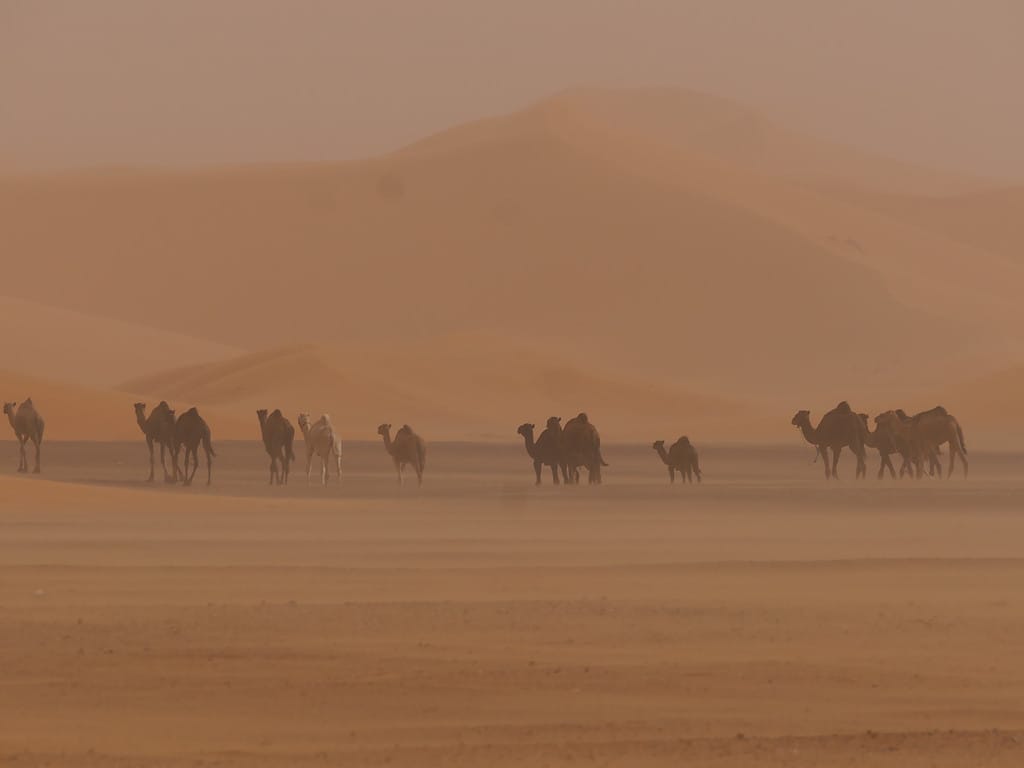
Wind storms relentlessly change the landscapes, specifically for sand dunes.
©Yvan Tessier/iStock via Getty Images
The desert formed over millions of years and continues to evolve to this day. The relentless winds in the desert contribute to the formation and constant shifting of its iconic sand dunes. The wind erosion creates intricate patterns and textures in the sand that can be totally different even within two days. Over time, the wind leads to the dunes migration across the landscape.
Even if rare, occasional flash floods significantly alter the Sahara’s topography. When flash floods happen, they carve wadis — dry river valleys that wind through the desert. During rare rainstorms, these wadis become channels for water and sometimes cut deep into the landscape, forming canyons and gorges. If a long period elapses without water, wadis may become dry again.
Additionally, human activities impacted the landscape. The impact is relatively small and localized. However, it still led to changes in land use and the introduction of non-native species.
Many Species Inhabit the Sahara Desert!

Camels are iconic to the Sahara Desert.
©Trevor Kittelty/iStock via Getty Images
Despite its harsh and arid conditions, the Sahara Desert is home to many wildlife that adapted to its challenging environment.
Antelope Species
The Sahara Desert is home to multiple antelope species. The addax is a critically endangered — less than 500 left — species living in parts of the Sahara. The Dorcas gazelle is a smaller species living in the Sahara. In the past, these species cohabited with the scimitar-horned oryx. This species was declared extinct in 2000. However, scientists have successfully bred the animal in captivity in recent years and hope to reintroduce it in the wild in the coming years. All these species adapted to the harsh conditions by reducing water loss and learning how to forage for desert vegetation.
Birds
Despite harsh and arid conditions, the Sahara is a major route for migratory birds, as some often stop near oases. It also serves as a breeding ground for various species. This includes desert eagles, sandgrouse, and multiple species of vultures.
Camels
The most famous, often featured in books, documentaries, and movies, symbolizes the Sahara. With its distinctive single hump, the dromedary camel is a vital resource for desert-dwelling communities. Camels can endure extreme temperatures and survive up to 15 days without water. They are often used for long treks across the desert.
Saharan Cheetah
The Saharan cheetah is a rare subspecies native to the Sahara and Sahel. Once critically endangered with less than 250 specimens in 2008, its population largely increased and is now roughly 8,000 cheetahs. They live in all parts of the Sahara but prefer mountainous areas and oases where they can find fresh water and shaded areas. They are by far the fastest animal in the Sahara Desert and its apex predator.
Others
- Desert Hedgehog: This nocturnal insectivore has a specialized kidney function to conserve water, allowing it to survive in the Sahara’s arid conditions.
- Desert Monitor: This small lizard is an agile predator which prey on small mammals, insects, and other creatures. They play a vital role in controlling the insect populations.
- Fennec Fox: Native to the deserts of North Africa, it is a small, nocturnal desert fox famous for its oversized ears that help dissipate heat. It feeds on insects, small mammals, and desert vegetation.
- Insects: The Sahara teems with insect life, from beetles to ants. All have evolved to survive in extreme weather. The darkling beetle has the ability to harvest moisture from fog.
The Sahara Desert Holds Extensive Cultural Significance

The Great Pyramids of Giza are one of the Seven Wonders of the Ancient World.
©StockByM/iStock via Getty Images
Outside of the stunning landscapes the Sahara Desert offers, it also holds a rich cultural history and extensive significance for its neighboring communities. The desert’s vastness and isolation contributed to the development of unique practices and traditions. Modern Saharan cultures celebrate how their culture and traditions thrived in one of the most challenging environments on Earth.
Ancient Egpyt
The northern edge of the Sahara was home to one of the most famous civilizations, ancient Egypt. The presence of the Nile River, which flows in the desert’s northern part, allowed the emergency of this powerful and advanced society. Ancient Egyptians built pyramids and countless temples, tombs, and artifacts.
Medieval Empires
The desert was also home to several medieval empires, including the Ghana Empire, Mali Empire, and Songhai Empire. These empires thrived from the trans-Saharan trade — especially gold — and were renowned for their wealth and cultural achievements.
Berber Culture
Indigenous to North Africa, the Berber people have a long history of inhabiting the Sahara. The Berber culture includes Amazigh languages — derived from ancient Egyptian — music, art, and nomadic traditions. The Tuareg, a subgroup of the Berbers, are famous for their blue clothing. They are often called the “Blue Men of the Sahara.”
Both these groups have lived throughout the deserts, specifically around oases. Their music, the Berber folk songs, and the Tuareg desert blues gained international recognition.
European Exploration
Heinrich Barth, René Caillié, and others ventured into the Sahara desert during European exploration. They documented the desert’s geography, culture, and traditions.
Islamic Influence
When Islam started to spread in North Africa, the religion significantly impacted the Sahara’s culture. Islamic architecture and art began to flourish in cities like Gao and Timbuktu. They became centers of Islamic learning.
Many Trade Routes Used the Sahara Desert
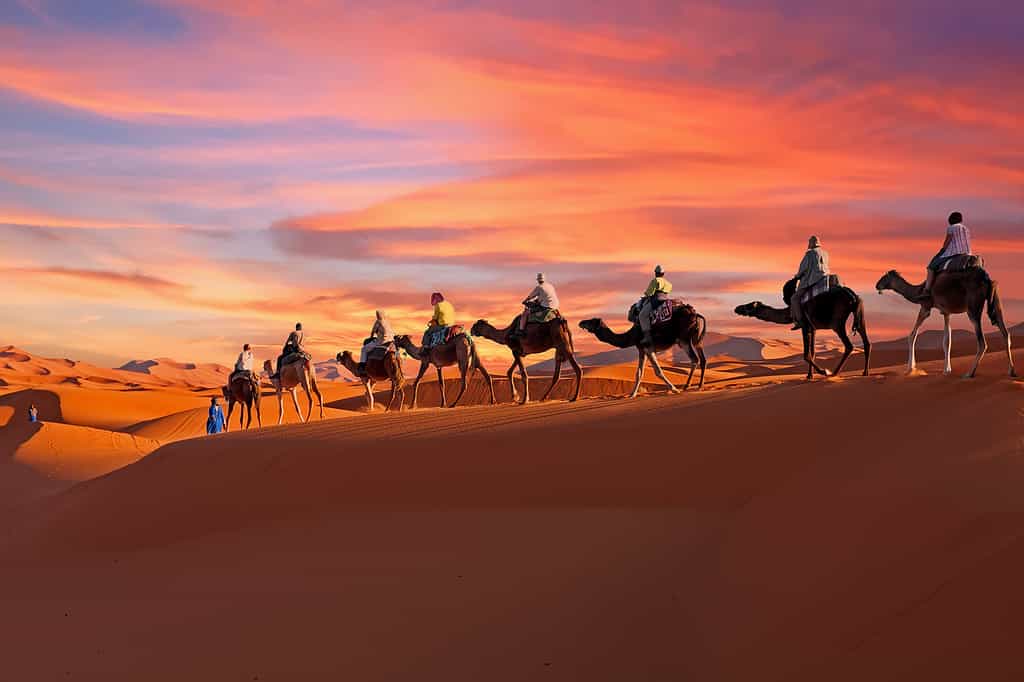
Trade routes could only exist with camels.
©Nisangha/iStock via Getty Images
Historically, the Sahara Desert served as a significant and vital trade route. The Trans-Saharan trade routes covered an extensive geographical area, primarily from the Maghreb region (modern-day Algeria, Morocco, Tunisia, and Libya) across the Sahara Desert into the Sahel region of Sub-Saharan Africa. They also often passed through oases, slowly establishing them as hubs for commerce.
The ancient commercial pathways played a crucial role in facilitating the exchange of cultures, goods, ideas, and people. For example, it helped the spread of Islam. They also played a significant role in the historical development of the region.
Caravans conducted the trains with hundreds or thousands of camels carrying the goods across the desert. Most of the time, these caravans were led by Berber or Tuareg traders, who perfectly knew the intricacies of navigating the Sahara Desert.
The Trans-Saharan trade routes declined with the European exploration of sea routes to the east. Specifically in the late 15th century with the establishment of the notable Vasco da Gama’s sea route to India. The decline of major regional empires also led to a fast decline in the trade routes.
Goods
- Gold, abundant in Sud-Saharan regions, was highly sought after by traders throughout the continent.
- Salt, used for food conservation purposes and seasoning, was a vital resource in the area. The Saharan salt mines, such as those in Taghaza, supplied a lot of salt to the north.
- Ivory, spices, textiles, and more: Outside of gold and salt, the trade routes were also used for many goods, including ivory, spices, textiles, and exotic products.
People
Unfortunately, the trade routes were also used for the slave trade. Captives from Sub-Saharan Africa were sold into North African and Mediterranean markets. Men were used for work, and women and girls were sold as sex slaves. It is estimated that this trade lasted for around 13 centuries and made 17 million victims. Hundreds of thousands of captives never made it across the Sahara.
The Saraha Boasts Ancient Rock Art and Fossils

The Sahara Desert boasts stunning ancient rock art.
©Mussa Regagda/iStock via Getty Images
Many communities lived in various parts of the Sahara Desert at different periods. Consequently, it is rich in historical and archaeological treasures, with ancient rock art. The presence of prehistoric fossils in the Sahara suggests that the desert was once a lush and tropical environment.
Rock Art
- Ancient Art: The Sahara is famous for its ancient rock art and petroglyphs. Found throughout the desert, they provide fascinating glimpses into the lives and beliefs of past civilizations.
- Tassili n’Ajjer: In Algeria, The Tassili n’Ajjer plateau is a UNESCO World Heritage Site famous for its rock art. The paintings and engraving are thousands of years old. Some of the art is attributed to the ancient Tuareg people and depicts scenes of daily life, animals, and abstract symbols.
- Saharan Wildlife: Some rock art focuses on animals that once roamed the region, like giraffes, elephants, and extinct species like the aurochs.
Prehistoric Fossils
- Fossil Record: The Sahara Desert boasts an extensive record of fossils dating back to various geological periods, including the Mesozoic era.
- Dinosaurs: Various dinosaur fossils have been discovered in the Sahara Desert. These include those of the Spinosaurus, a massive aquatic dinosaur that lived around 112 million years ago.
- Ancient Human Ancestors: In sites like Jebel Irhoud in Morocco, archaeologists found human fossils of Homo sapiens dating to approximately 300,000 years ago.
It Is the Perfect Place for Astronomical Observation
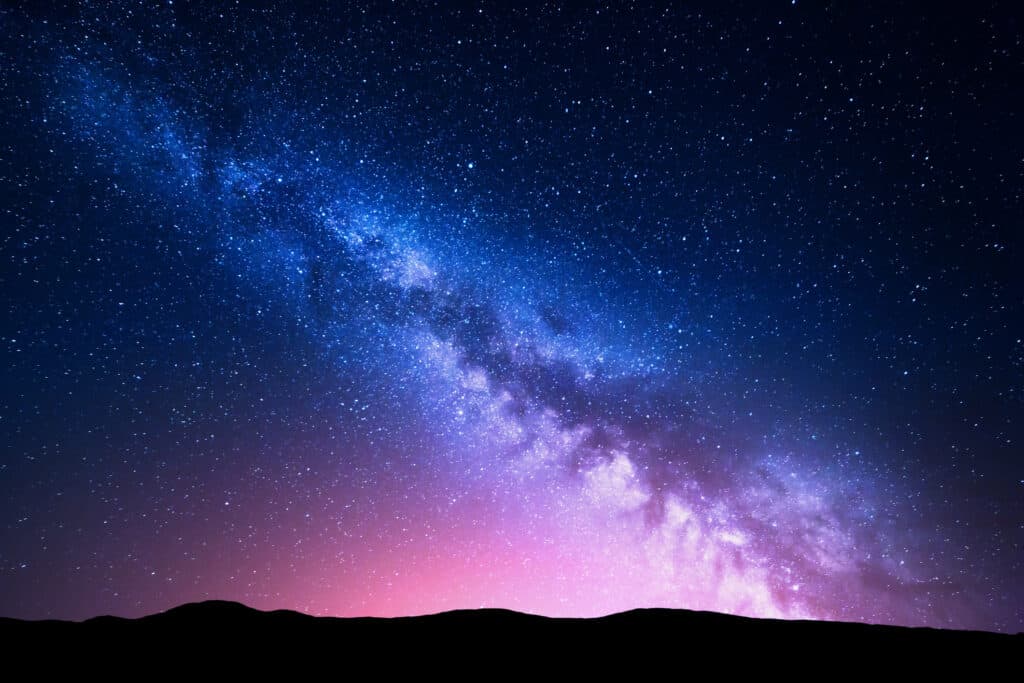
The desert is one of the most stunning places to see the Milky Way.
©iStock.com/den-belitsky
The Sahara Desert benefits from several unique features perfect for sky observation.
With its extreme remoteness and lack of few to no human settlements, the Sahara Desert is protected from light pollution. The lack of artificial light interference allows telescopes to capture more precise and more detailed images of the night sky. Numerous observatories have been established in the desert to take advantage of the almost perfect conditions.
The Sahara Desert also experiences low humidity and almost no cloud cover, resulting in exceptionally dark skies. In these conditions, celestial objects such as stars, planets, galaxies, and nebulae are more vividly visible. Additionally, most regions of the Sahara experience stable atmospheric conditions, particularly at night, reducing the distortion caused by the Earth’s atmosphere. This makes astronomical observation easier and the study of celestial objects with high precision.
Due to Sahara’s abundant sunlight, it is also one of the best places for solar observations. Solar observatories study the sun’s surface, flares, and other phenomena.
The Sahara Desert is often the site of astronomical research projects and collaborations. Many scientists from around the world come to the Sahara Desert for work. The observatories often host educational projects aiming to promote scientific and astronomical curiosity.
Additionally, the Sahara Desert is now a popular destination for amateur astronomers and astrophotographers. Tourists visiting the desert can witness celestial events like meteor showers, eclipses, and the stunning Milky Way like never before.
The Sahara Desert Is the Backdrop of Many Movies

Some scenes of the iconic Star Wars saga were shot in the Sahara Desert.
©Mirko Toller / CC BY 2.0 – License
The Sahara’s iconic dunes, oasis, and arid landscapes made it a popular choice as the backdrop for many movies. Filming in the Sahara Desert presents logistical challenges but rewards with incredible landscapes and backdrop possibilities.
- Lawrence of Arabia (1962): This movie, directed by David Lean, tells the story of T.E. Lawrence’s adventures during World War I in the Arabian Peninsula.
- The English Patient (1996): This romantic drama, directed by Anthony Minghella, is set in multiple North African locations, including the Sahara Desert.
- Star Wars Series: Several scenes from Star Wars, specifically “A New Hope” and “Return of the Jedi”) were filmed in the Tunisian part of the Sahara Desert. The dunes and rocky landscapes are the backdrop of the desert planet Tatooine, the homeworld of Luke Skywalker.
- The Mummy (1999): Directed by Stephen Sommers, this adventure film features scenes in the Sahara Desert.
- The Sheltering Sky (1990): The Sahara plays a symbolic role in the story of this movie based on the novel by Paul Bowles.
- Gladiator (2000): A few shots of Gladiator were shot in the Moroccan Sahara Desert.
- Sahara (2005): This action-adventure movie, starring Matthew McConaughey and Penélope Cruz, was filmed in various parts of the Sahara Desert.
- The Hills Have Eyes (2006): This horror film, directed by Alexandre Aja, was filmed in the Moroccan Sahara Desert.
The photo featured at the top of this post is © Mik122/iStock via Getty Images
Thank you for reading! Have some feedback for us? Contact the AZ Animals editorial team.



